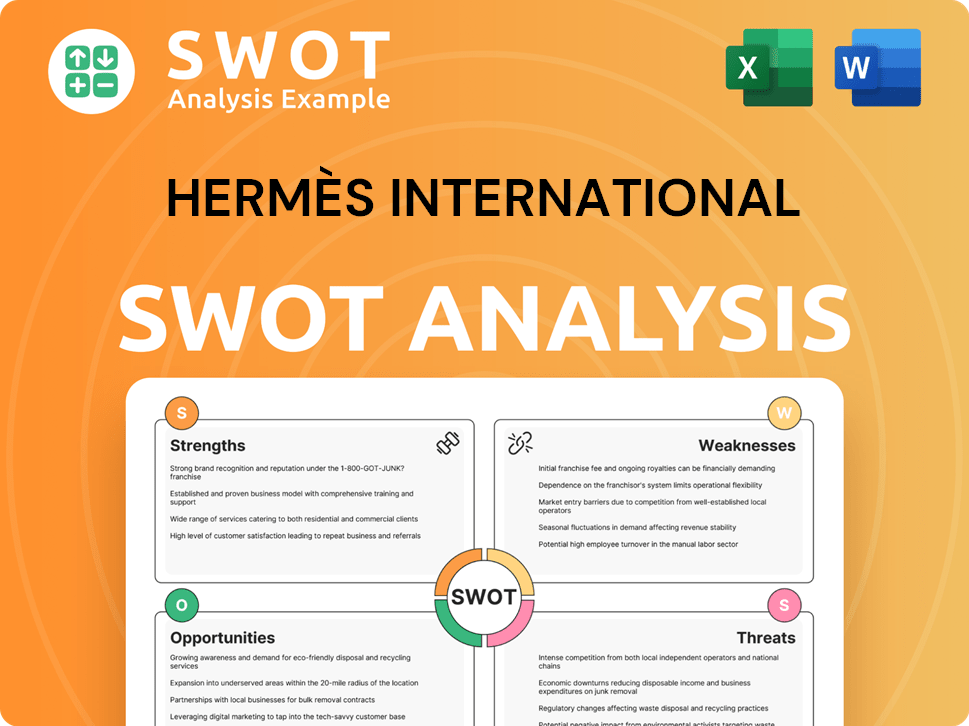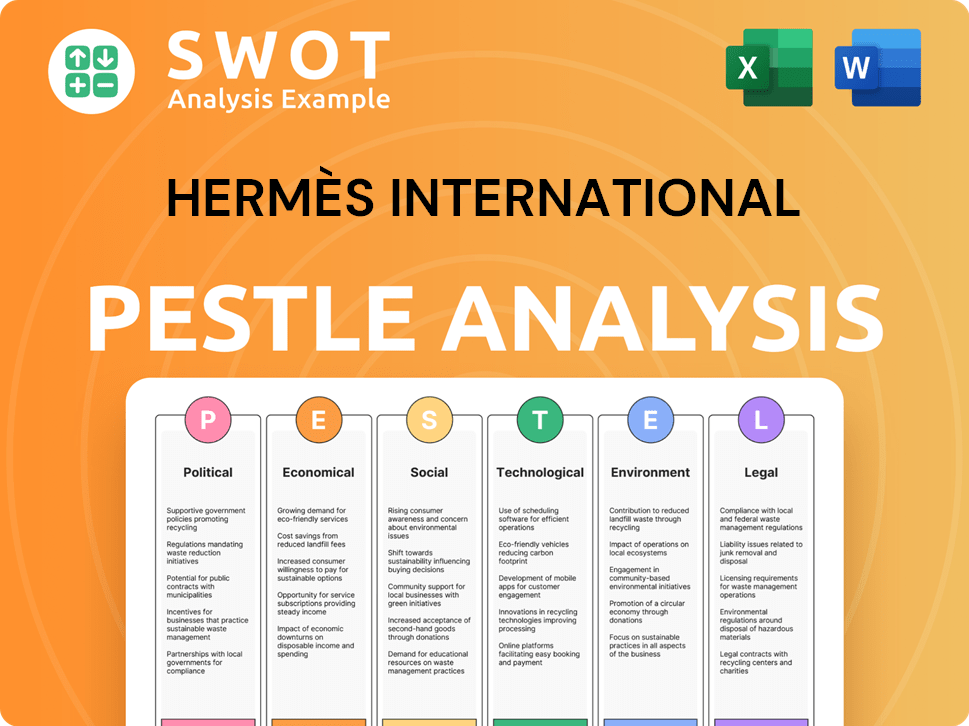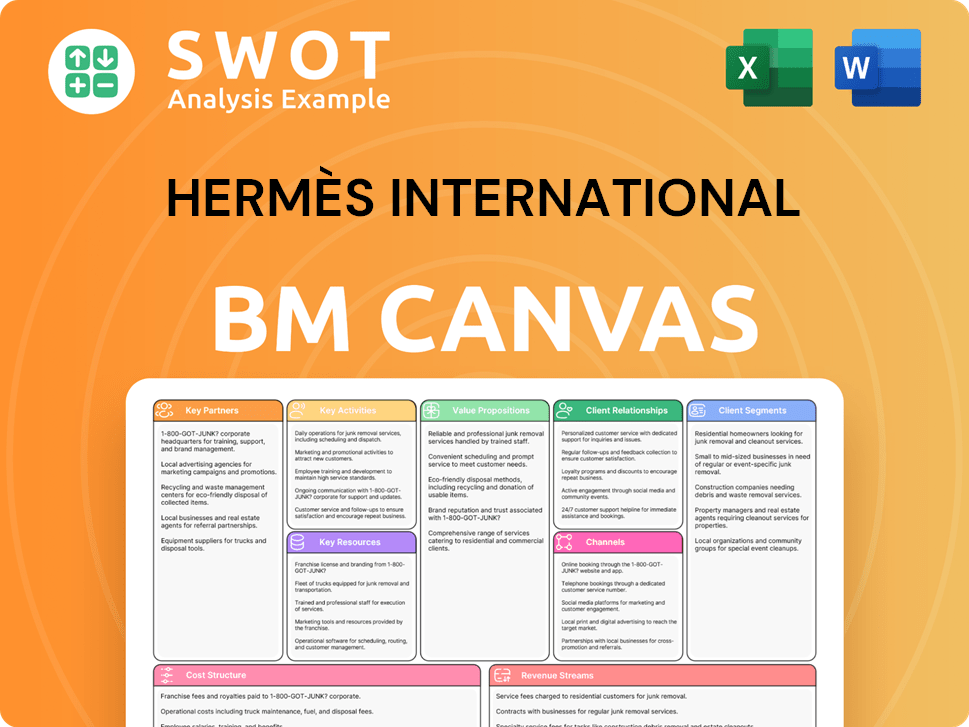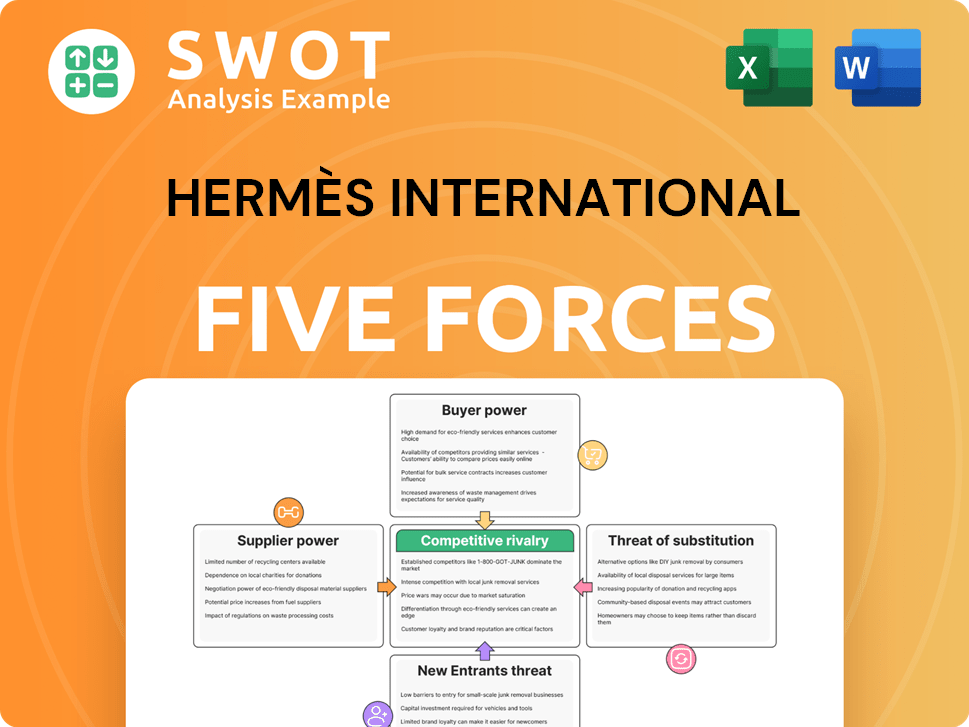Hermès International Bundle
Who Really Owns Hermès?
Unraveling the ownership of a luxury giant like Hermès is crucial for understanding its trajectory. The Hermès International SWOT Analysis reveals the strategic landscape shaped by its ownership structure. In 2010, the Hermès family fiercely defended its independence against LVMH, a pivotal moment that underscores the importance of understanding who controls this iconic brand. This exploration dives deep into the ownership saga of Hermès.

From its humble beginnings as a harness workshop in 1837, Hermès has transformed into a global luxury leader. Understanding the Hermès ownership structure, from the founding family to today's shareholders, provides critical insights into its enduring legacy. This analysis of the Hermès company will examine key aspects like Hermès owner, Hermès brand, and the influence of major shareholders, offering a comprehensive view of this luxury brand's ownership.
Who Founded Hermès International?
The story of Hermès International begins in 1837, when Thierry Hermès established a workshop in Paris. Initially, the company focused on crafting high-quality horse harnesses and bridles, setting the stage for the luxury brand's future. Thierry Hermès's dedication to craftsmanship quickly earned the company renown, laying the groundwork for its future success and recognition.
Thierry Hermès, born in 1801, moved to France and honed his skills as a harness-maker. His commitment to excellence was evident in the 'saddle stitch' he developed, a hallmark of Hermès's quality. This meticulous attention to detail became a defining characteristic of the brand, contributing to its reputation for elegance and durability.
The company's evolution from a saddlery to a broader luxury brand reflects the strategic decisions made by successive generations of the Hermès family. This transition highlights the importance of adapting to changing market conditions while maintaining a commitment to quality and craftsmanship. Understanding the lineage of Hermès ownership is key to appreciating its enduring legacy.
Thierry Hermès, the founder, started the company in 1837 in Paris. His focus was on creating high-quality horse harnesses and bridles. This initial specialization set the tone for the brand's commitment to craftsmanship.
Charles-Émile Hermès took over in 1880, moving the company to its iconic location. He expanded the business to include international retail sales, though saddlery remained a primary focus.
Émile-Maurice Hermès acquired the rights to the zipper for leather goods in France. This innovation, known as the 'Hermès Fastener,' marked a shift towards diversification.
Émile-Maurice Hermès diversified the brand, recognizing the decline of carriages. This included introducing the first leather golf jacket with a zipper in 1918.
Émile-Maurice brought his sons-in-law, Robert Dumas, Jean-René Guerrand, and Francis Puech, into the company. This ensured family leadership for the future.
The company's early strategic shifts involved adapting to new technologies and consumer needs. This included moving from saddlery to a broader range of luxury goods.
Understanding the history of Hermès's target market is crucial for appreciating its brand value and ownership structure. The Hermès company's journey from a saddlery to a global luxury brand showcases the importance of adaptability and family involvement. The early ownership structure, marked by the founders and their descendants, set the stage for the brand's enduring success.
- Thierry Hermès founded the company in 1837, specializing in harnesses and bridles.
- Charles-Émile Hermès expanded the business and moved to the iconic location.
- Émile-Maurice Hermès diversified the brand and introduced the zipper.
- Family members, including sons-in-law, played key roles in leadership.
Hermès International SWOT Analysis
- Complete SWOT Breakdown
- Fully Customizable
- Editable in Excel & Word
- Professional Formatting
- Investor-Ready Format

How Has Hermès International’s Ownership Changed Over Time?
The evolution of Hermès ownership reflects a strong commitment to family control, even after becoming a publicly traded company. The Hermès company went public in 1993, listed on Euronext Paris under the ticker RMS. The Hermès family has consistently maintained a significant stake, ensuring the brand's independence and adherence to its core values. This approach has been crucial in navigating challenges and maintaining the brand's identity within the luxury market.
A pivotal moment in Hermès's history was the acquisition of a significant stake by LVMH in 2010. This event prompted the Hermès family to consolidate its ownership to prevent a potential takeover. Although LVMH later reduced its direct involvement, the family's resolve to maintain control was solidified. This strategic move underscores the importance of preserving the brand's heritage and long-term vision, which is a key factor in the luxury brand ownership landscape.
| Shareholder | Stake (as of Dec 30, 2024) | Stake (as of April 29, 2025) |
|---|---|---|
| H51 SAS (Hermès Family) | 54.70% | N/A |
| H2 SAS (Hermès Family) | 6.69% | N/A |
| Direct Hermès Family Group | 5.79% | N/A |
| BlackRock, Inc. | N/A | 1.71% |
| The Vanguard Group, Inc. | N/A | 1.30% (as of March 30, 2025) |
Beyond the Hermès family, institutional investors hold notable stakes in the company. BlackRock, Inc. held 1.71% of shares as of April 29, 2025, and The Vanguard Group, Inc. held 1.30% as of March 30, 2025. Other significant holders include Capital Research and Management Company (0.81% as of April 29, 2025), and Amundi Asset Management SAS (0.56% as of December 30, 2024). These investments, while substantial, are secondary to the family's control, which continues to guide the company's strategy, emphasizing brand heritage and craftsmanship. For more details on the company's strategic direction, consider reading about the Growth Strategy of Hermès International.
The Hermès owner, the Hermès family, maintains significant control, ensuring brand independence.
- The company went public in 1993, but the family retained the majority stake.
- LVMH's investment in 2010 prompted the family to consolidate its ownership.
- Institutional investors hold stakes, but family control remains dominant.
- The market capitalization reached €245.13 billion as of December 31, 2024.
Hermès International PESTLE Analysis
- Covers All 6 PESTLE Categories
- No Research Needed – Save Hours of Work
- Built by Experts, Trusted by Consultants
- Instant Download, Ready to Use
- 100% Editable, Fully Customizable

Who Sits on Hermès International’s Board?
The current board of directors of Hermès International is a mix of family members and independent members. Key leadership roles are held by descendants of the founding family. Eric de Seynes is the Chairman, and Axel Dumas, a sixth-generation heir, serves as Executive Chairman. Other family members include Pierre-Alexis Dumas and Guillaume de Seynes.
The Hermès family's influence is substantial due to their significant shareholding. This structure allows the family to maintain control even as a publicly traded company. Recent appointments highlight a focus on strengthening expertise and governance. The average tenure of the management team is 11.8 years, and the board of directors is 12.5 years, indicating stable leadership.
| Board Member | Position | Details |
|---|---|---|
| Eric de Seynes | Chairman | Oversees the board's activities and strategic direction. |
| Axel Dumas | Executive Chairman | Leads the company's strategy and operations. |
| Pierre-Alexis Dumas | Artistic Executive Vice President | Responsible for the artistic direction of the brand. |
| Guillaume de Seynes | Executive Vice President of the Manufacturing Division and Equity Investments | Manages manufacturing and investment strategies. |
The Hermès family controls approximately 67% of the company's share capital, giving them significant voting power. As of February 28, 2025, the total number of shares was 105,569,412, with 179,437,557 theoretical voting rights and 178,705,118 effective voting rights. This structure allows the family to maintain control. For a deeper understanding of the company's origins, you can explore the Brief History of Hermès International.
The Hermès family's significant ownership stake ensures their continued influence over the luxury brand. This structure is maintained through a combination of direct shareholdings and voting rights arrangements.
- Family members hold key leadership positions.
- The family controls approximately 67% of the company's share capital.
- Dual-class share structure or similar arrangements are in place.
- Recent board appointments focus on strengthening governance.
Hermès International Business Model Canvas
- Complete 9-Block Business Model Canvas
- Effortlessly Communicate Your Business Strategy
- Investor-Ready BMC Format
- 100% Editable and Customizable
- Clear and Structured Layout

What Recent Changes Have Shaped Hermès International’s Ownership Landscape?
Over the past few years, Hermès International has demonstrated strong financial performance, maintaining its unique ownership structure. The company's market capitalization briefly reached €300 billion after the 2024 results were announced on February 14, 2025, reflecting its robust financial health. The Hermès family, which controls just over two-thirds of the shares, is set to receive over $5 billion in dividends, following four record-breaking years. The company approved an ordinary dividend of €16.00 per share and an exceptional dividend of €10.00 per share for the financial year 2024, which was approved on April 30, 2025. An interim cash dividend of €3.50 per share was paid on February 19, 2025, with the balance paid on May 7, 2025. This underscores the family's continued influence and commitment to the brand.
In 2024, Hermès International redeemed 21,316 shares for €40 million, excluding transactions within the liquidity contract framework. This demonstrates the company's strategy regarding its shares. While the luxury industry has seen increased institutional ownership and, at times, activist investor campaigns, Hermès has largely maintained its independence due to the consolidated family control. The company's majority stake in its retail activities in the United Arab Emirates, established in January 2024, further highlights its strategic expansions.
| Metric | Value | Date |
|---|---|---|
| Market Capitalization (briefly) | €300 billion | February 14, 2025 |
| Ordinary Dividend per Share | €16.00 | Approved April 30, 2025 |
| Exceptional Dividend per Share | €10.00 | Approved April 30, 2025 |
| Interim Cash Dividend per Share | €3.50 | Paid February 19, 2025 |
| Shares Redeemed | 21,316 | 2024 |
| Value of Shares Redeemed | €40 million | 2024 |
| H51 SAS Ownership | 54.70% | December 30, 2024 |
The Hermès family's significant ownership, primarily through holding companies like H51 SAS (54.70% as of December 30, 2024), insulates the company from external pressures. This structure has allowed Hermès to maintain its focus on its artisan model, creativity, and savoir-faire, with the majority of its production remaining in France. Public statements from the company emphasize preserving brand heritage and maintaining exclusivity, which are deeply intertwined with its family ownership structure. There were no reported leadership or founder departures in executive management in financial year 2024, nor any changes since December 31, 2024, reinforcing the stability of the company's leadership.
The Hermès family owns the majority of the company. The family's control ensures the preservation of the brand's heritage and exclusivity. The ownership structure has remained stable, with no significant changes reported recently.
The Hermès family's ownership is primarily maintained through holding companies. H51 SAS holds a significant percentage of shares. This structure allows the family to maintain control and influence over the company's direction.
Hermès has shown strong financial performance. The company's market capitalization briefly touched €300 billion. The company announced record dividends, reflecting its financial health and success.
Hermès is expected to maintain its commitment to its artisan model and exclusivity. The company's focus on brand heritage and family ownership is expected to continue. The company's strategic expansions, such as the majority stake in the UAE retail activities, are also significant.
Hermès International Porter's Five Forces Analysis
- Covers All 5 Competitive Forces in Detail
- Structured for Consultants, Students, and Founders
- 100% Editable in Microsoft Word & Excel
- Instant Digital Download – Use Immediately
- Compatible with Mac & PC – Fully Unlocked

Related Blogs
- What are Mission Vision & Core Values of Hermès International Company?
- What is Competitive Landscape of Hermès International Company?
- What is Growth Strategy and Future Prospects of Hermès International Company?
- How Does Hermès International Company Work?
- What is Sales and Marketing Strategy of Hermès International Company?
- What is Brief History of Hermès International Company?
- What is Customer Demographics and Target Market of Hermès International Company?
Disclaimer
All information, articles, and product details provided on this website are for general informational and educational purposes only. We do not claim any ownership over, nor do we intend to infringe upon, any trademarks, copyrights, logos, brand names, or other intellectual property mentioned or depicted on this site. Such intellectual property remains the property of its respective owners, and any references here are made solely for identification or informational purposes, without implying any affiliation, endorsement, or partnership.
We make no representations or warranties, express or implied, regarding the accuracy, completeness, or suitability of any content or products presented. Nothing on this website should be construed as legal, tax, investment, financial, medical, or other professional advice. In addition, no part of this site—including articles or product references—constitutes a solicitation, recommendation, endorsement, advertisement, or offer to buy or sell any securities, franchises, or other financial instruments, particularly in jurisdictions where such activity would be unlawful.
All content is of a general nature and may not address the specific circumstances of any individual or entity. It is not a substitute for professional advice or services. Any actions you take based on the information provided here are strictly at your own risk. You accept full responsibility for any decisions or outcomes arising from your use of this website and agree to release us from any liability in connection with your use of, or reliance upon, the content or products found herein.